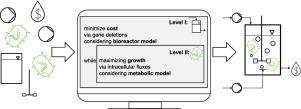微生物与生物反应器同步设计
IF 3.9
2区 工程技术
Q2 COMPUTER SCIENCE, INTERDISCIPLINARY APPLICATIONS
引用次数: 0
摘要
当开发生物技术过程时,首先设计微生物,例如,使用代谢工程。然后,在实验室规模上确定最佳发酵参数,最后转移到生物反应器规模。然而,这种循序渐进的方法既昂贵又耗时,并且可能导致次优配置。在此,我们提出了双层优化配方SimulKnockReactor,它将生物反应器设计与微生物菌株设计联系起来,是我们之前配方SimulKnock的扩展(Ziegler等人,2024)。在上层(生物反应器),我们通过确定连续搅拌池反应器的尺寸和操作条件,将搅拌、曝气和pH控制的投资和运行成本降至最低,而无需选择搅拌器类型等特定设备。较低(细胞)水平是基于通量平衡分析,并实现最优的反应敲除由上层预测。我们对大肠杆菌的核心和基因组尺度代谢模型的研究结果表明,底物是最大的成本因素。我们的同步方法优于使用OptKnock的顺序方法。也就是说,OptKnock提出的淘汰方案并不能在所有考虑的情况下保证所需的生产能力。另一方面,SimulKnockReactor在所有情况下都提供了解决方案,突出了细胞和生物反应器水平相结合的优势。这项工作是迈向完全集成的生物工艺设计的又一步。本文章由计算机程序翻译,如有差异,请以英文原文为准。

Simultaneous design of microbe and bioreactor
When developing a biotechnological process, the microorganism is first designed, e.g., using metabolic engineering. Then, the optimum fermentation parameters are determined on a laboratory scale, and lastly, they are transferred to the bioreactor scale. However, this step-by-step approach is costly and time-consuming and may result in suboptimal configurations. Herein, we present the bilevel optimization formulation SimulKnockReactor, which connects bioreactor design with microbial strain design, an extension of our previous formulation, SimulKnock (Ziegler et al., 2024). At the upper (bioreactor) level, we minimize investment and operation costs for agitation, aeration, and pH control by determining the size and operating conditions of a continuous stirred-tank reactor—without selecting specific devices like the stirrer type. The lower (cellular) level is based on flux balance analysis and implements optimal reaction knockouts predicted by the upper level. Our results with a core and a genome-scale metabolic model of Escherichia coli show that the substrate is the largest cost factor. Our simultaneous approach outperforms a sequential approach using OptKnock. Namely, the knockouts proposed by OptKnock cannot guarantee the required production capacity in all cases considered. SimulKnockReactor, on the other hand, provides solutions in all cases considered, highlighting the advantage of combining cellular and bioreactor levels. This work is a further step towards a fully integrated bioprocess design.
求助全文
通过发布文献求助,成功后即可免费获取论文全文。
去求助
来源期刊

Computers & Chemical Engineering
工程技术-工程:化工
CiteScore
8.70
自引率
14.00%
发文量
374
审稿时长
70 days
期刊介绍:
Computers & Chemical Engineering is primarily a journal of record for new developments in the application of computing and systems technology to chemical engineering problems.
 求助内容:
求助内容: 应助结果提醒方式:
应助结果提醒方式:


